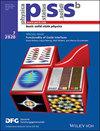非晶态 GeS2 中光学吸收边缘的再现性
IF 1.8
4区 物理与天体物理
Q3 PHYSICS, CONDENSED MATTER
引用次数: 0
摘要
从这里可以看出,GeS2 玻璃和薄膜中光学吸收边的再现性很差。据报道,熔淬玻璃中吸收边的光谱位置分布在ω ≈ 3 eV处≈0.2 eV。在沉积薄膜中,边缘红移到ħ ω ≈ 2.5 eV,变化范围≈1 eV。这项研究借助 Ge-S 簇的 ab initio 分子轨道分析以及对光学间隙、电子自旋共振信号和结构数据的已知见解,探讨了光谱重现性如此之低的可能原因。玻璃中的变化可能受多种因素的影响,包括成分波动、边缘/角落共享构型、错键和亲密的价偶对。薄膜中明显的红移现象似乎也受到中性悬空键的影响。本文章由计算机程序翻译,如有差异,请以英文原文为准。
Reproducibility of the Optical Absorption Edge in Amorphous GeS2
Herein, poor reproducibility of optical absorption edges in GeS2 glasses and films is seen. Reported spectral positions of the absorption edge in melt‐quenched glasses spread over ≈0.2 eV at ħω ≈ 3 eV. In deposited films, the edge red‐shifts to ħω ≈ 2.5 eV showing wider variations of ≈1 eV. This work considers plausible reasons of such low, spectral reproducibility, with the aid of ab initio molecular orbital analyses of Ge–S clusters and known insights on optical gaps, electron‐spin‐resonance signals, and structural data. The variation in the glass is likely to be governed by several factors including compositional fluctuation, edge/corner‐shared configurations, wrong bonds, and intimate valence‐alternation pairs. The conspicuous red‐shift in the films seems to be affected also by neutral dangling bonds.
求助全文
通过发布文献求助,成功后即可免费获取论文全文。
去求助
来源期刊
CiteScore
3.30
自引率
6.20%
发文量
321
审稿时长
2 months
期刊介绍:
physica status solidi is devoted to the thorough peer review and the rapid publication of new and important results in all fields of solid state and materials physics, from basic science to applications and devices. Being among the largest and most important international publications, the pss journals publish review articles, letters and original work as well as special issues and conference contributions.
physica status solidi b – basic solid state physics is devoted to topics such as theoretical and experimental investigations of the atomistic and electronic structure of solids in general, phase transitions, electronic and optical properties of low-dimensional, nano-scale, strongly correlated, or disordered systems, superconductivity, magnetism, ferroelectricity etc.

 求助内容:
求助内容: 应助结果提醒方式:
应助结果提醒方式:


